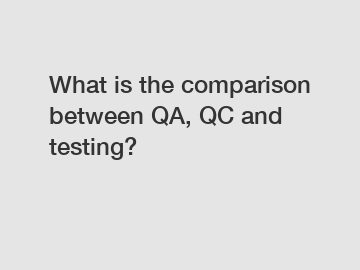What is the comparison between QA, QC and testing?
Quality assurance (QA), quality control (QC), and testing are three essential components of ensuring the quality of a product or service. While they are often used interchangeably, each plays a distinct role in the overall quality management process. Understanding the differences between QA, QC, and testing can help organizations improve their products and services while maintaining high standards.
**Quality Assurance (QA)**.
Quality assurance (QA) focuses on the processes used to create a product or service to ensure that quality standards are met. QA is a proactive approach that involves setting up guidelines, standards, and processes to prevent defects from occurring in the first place. This could include establishing quality standards, conducting audits, and implementing continuous improvement processes.

By implementing QA practices, organizations can identify potential issues early in the development process and make necessary changes to prevent defects from occurring. The goal of QA is to ensure that the final product meets all specified requirements and is of the highest quality possible.
**Quality Control (QC)**.
Quality control (QC), on the other hand, is a reactive approach that focuses on identifying defects in the final product or service. QC activities are typically performed at the end of the production process and involve inspecting the product to ensure that it meets all quality standards. This could include things like product testing, sampling, and inspection processes.
QC is crucial for identifying and fixing any defects that may have occurred during the production process. By implementing QC practices, organizations can ensure that only high-quality products are sent to customers, thus improving customer satisfaction and reducing the risk of returns or recalls.
**Testing**.
Testing is a subset of QC that involves evaluating the functionality and performance of a product to identify any defects. Testing can be done at various stages of development, including unit testing, integration testing, system testing, and user acceptance testing. The goal of testing is to ensure that the product meets all specified requirements and functions as intended.
Testing is essential for identifying any issues that may have been missed during the development process. By conducting thorough testing, organizations can uncover bugs, performance issues, or usability issues that need to be addressed before the product is released to customers.
**Conclusion**.
In conclusion, QA, QC, and testing are all critical components of ensuring the quality of a product or service. While QA focuses on preventing defects through established processes, QC is responsible for identifying and fixing defects in the final product. Testing plays a vital role in evaluating the product's functionality and performance to ensure it meets all specified requirements.
By understanding the differences between QA, QC, and testing, organizations can implement effective quality management practices to improve their products and services. By focusing on both prevention and detection, companies can deliver high-quality products that meet customer expectations and drive business success.
If you have any questions or need assistance with quality management practices, feel free to contact us.
Contact us to discuss your requirements of geogrid mesh, geomembrane supplier, application of geomembrane in environmental protection compa. Our experienced sales team can help you identify the options that best suit your needs.
106
0
0


Comments
All Comments (0)